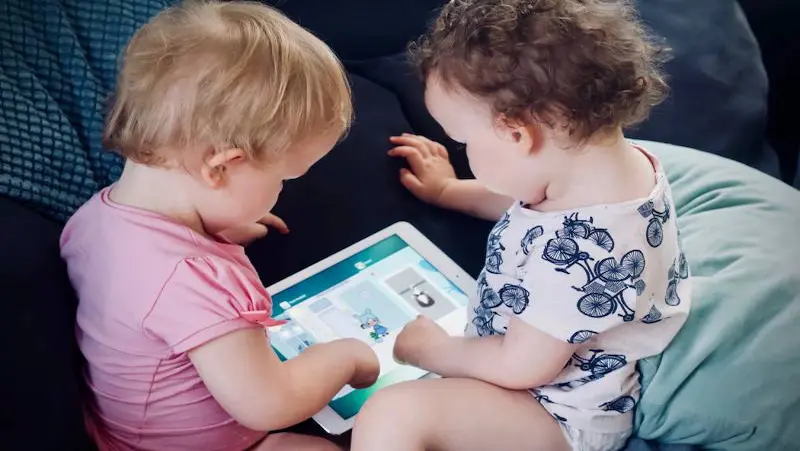Are you a parent looking for fun and educational videos that will captivate and engage your kids?
Then this blog is for you! In today’s digital age, video content has become an increasingly popular medium for children’s entertainment and learning. With a wide range of options available, it can be overwhelming to find the right videos that strike the perfect balance between entertainment and education.
Fortunately, we have curated a collection of fantastic videos that will both entertain and educate your little ones. These videos cover a wide range of subjects, from science and nature to history and art. Each video is carefully designed to spark curiosity, promote critical thinking, and encourage active learning.
Our fun and educational videos feature captivating visuals, lively animations, and interactive elements that make learning an enjoyable experience. They are created by experts in child development and education, ensuring that the content is age-appropriate and aligned with educational standards.
So, sit back, relax, and let your kids embark on an exciting journey of knowledge and discovery through our carefully selected collection of fun and educational videos. Get ready to witness their eyes light up with wonder and their minds expand with new knowledge.
Let the learning adventure begin!
Table of contents
Introduction
Fun and educational videos are a fantastic resource for parents seeking to provide their kids with a combination of entertainment and learning. These videos are specifically designed to captivate young minds while delivering valuable knowledge and skills. They cover a wide range of subjects, including science, math, language, history, art, and more.
What sets these videos apart is their ability to make learning enjoyable through engaging visuals, animated characters, and interactive elements. They are carefully crafted by experts in child development and financial education for kids, ensuring that the content is age-appropriate and aligned with educational standards.

Fun and educational videos not only entertain kids but also foster their cognitive, social, and emotional development. They stimulate curiosity, critical thinking, and creativity, providing a foundation for lifelong learning.
So, as a parent, if you’re looking for an effective and entertaining way to educate your children, fun and educational videos are an excellent choice. Let your kids embark on a thrilling educational journey, where learning becomes an adventure filled with excitement and joy!
Discover a captivating collection of videos for kids that seamlessly blend fun and education, sparking curiosity and fostering learning in an engaging way.
Why Videos Are Great for Kids
Videos have become an increasingly popular educational and entertainment tool for children and for good reason. Here are some of the benefits of using videos as a medium for kids:
1. Visual Engagement: Videos provide a visual and audio experience that can capture children’s attention and keep them engaged for longer periods. Visual aids, animations, and vibrant colors make learning more exciting and memorable.
2. Information Retention: Visual and auditory cues in videos enhance children’s ability to absorb and retain information. The combination of visuals, sounds, and narratives helps reinforce concepts and improve comprehension.
3. Multisensory Learning: Videos engage multiple senses, such as sight and hearing, making the learning experience more immersive. This multisensory approach can enhance children’s understanding of abstract concepts and promote better overall learning outcomes.
4. Interactive Elements: Many educational videos incorporate interactive elements, such as quizzes, puzzles, or clickable features, which encourage active participation and reinforce learning. These interactive elements can boost children’s engagement and critical thinking skills.
5. Accessibility and Convenience: Videos can be accessed easily through various platforms, such as online streaming services, websites, or educational apps. They provide flexibility in terms of when and where children can watch, making learning opportunities readily available.
6. Diversity of Content: Videos cover a wide range of subjects, from academic topics to social-emotional learning and life skills. This diversity allows children to explore various interests, discover new topics, and develop a well-rounded knowledge base.
7. Cultural and Global Awareness: Videos offer a window into different cultures, languages, and perspectives. They expose children to diverse backgrounds, fostering empathy, tolerance, and global awareness.
8. Personalized Learning: With a plethora of videos available, parents can choose content tailored to their children’s age, interests, and learning style. This personalized approach ensures that the videos cater to individual needs and maximize learning potential.
9. Supplementary Learning Tool: Videos can complement traditional teaching methods, serving as a valuable supplementary tool for classroom instruction or homeschooling. They reinforce concepts, provide visual examples, and offer additional explanations.
10. Motivation and Fun: Educational videos often combine entertainment and learning, making the experience enjoyable for children. This intrinsic motivation can inspire a love for learning and encourage children to seek out knowledge independently.
When used mindfully and in moderation, videos can be a powerful tool for children’s education and entertainment. They have the potential to spark curiosity, stimulate intellectual growth, and ignite a lifelong passion for learning.

Different Types of Videos for Kids
There is a wide variety of videos available for kids, catering to different interests and learning preferences. Here are some of the different types of videos that children can enjoy:
1. Educational Documentaries: These videos provide in-depth knowledge on various subjects such as science, nature, history, geography, and wildlife. Documentaries present real-life footage, interviews, and expert explanations, offering a more informative and factual approach to learning.
2. Animated Shows: Animated videos are a popular choice for kids, combining entertainment and education. They often feature colorful characters, engaging storylines, and interactive elements to teach concepts such as numbers, letters, problem-solving, and social skills.
3. Science Experiments and Demonstrations: Science-based videos showcase hands-on experiments and demonstrations that captivate children’s curiosity. These videos allow kids to witness scientific concepts in action, fostering a love for exploration and discovery.
4. Music Videos: Music videos for kids combine catchy tunes, engaging visuals, and interactive elements to teach various subjects like phonics, math facts, vocabulary, and even foreign languages. They make learning fun and memorable through the power of music and rhythm.
5. Art and Craft Tutorials: Videos that feature art and craft tutorials inspire creativity and help children develop their artistic skills. These videos provide step-by-step instructions for drawing, painting, sculpting, and creating various DIY projects.
6. Storytelling and Book Adaptations: Videos that bring stories to life through animated or live-action adaptations of popular children’s books are captivating for kids. They promote literacy skills, imagination, and a love for reading.
7. Language Learning Videos: Language learning videos introduce kids to new languages through engaging visuals, songs, and interactive activities. They teach vocabulary, pronunciation, basic phrases, and cultural aspects of different languages.
8. Physical Activity and Exercise Videos: These videos encourage children to be active and promote physical fitness. They include dance routines, yoga sessions, aerobic exercises, and fun workouts tailored for kids.
9. Virtual Field Trips: Virtual field trip videos allow kids to explore different places, cultures, and environments from the comfort of their homes. They provide a glimpse into museums, historical sites, national parks, and other fascinating locations.
10. Life Skills and Social-Emotional Learning: Videos focusing on life skills and social-emotional learning covers topics like empathy, kindness, friendship, problem-solving, and resilience. They help children navigate various social situations and develop emotional intelligence.
These are just a few examples of the diverse types of videos available for kids. The variety ensures that there is something for every child’s interests, learning style, and age group, making the learning experience engaging, entertaining, and educational.
Also, explore a world of language with delightful tongue twisters for kids, coupled with fun and educational videos that make learning a playful and enjoyable experience.

How to Choose the Right Videos for Your Child
Choosing the right videos for your child can enhance their learning experience and ensure that the content is age-appropriate and engaging. Here are some tips to help you select appropriate videos based on your child’s age and interests:
1. Consider Age-Appropriate Content: Look for videos that are specifically designed for your child’s age group. Many videos mention the recommended age range in their descriptions or titles. Consider the complexity of the content, the language used, and the concepts covered to ensure they align with your child’s developmental stage.
2. Read Reviews and Ratings: Before allowing your child to watch a video, read reviews and check ratings from other parents or reputable sources. This can give you insights into the quality, educational value, and appropriateness of the content.
3. Prioritize Educational Content: Look for videos that have a clear educational focus. Consider the subjects covered, the depth of information provided, and the learning outcomes. Educational videos that are entertaining and engaging can make learning enjoyable for your child.
4. Match Interests and Hobbies: Choose videos that align with your child’s interests, hobbies, or curiosities. Whether they are interested in animals, space, art, or music, finding videos that cater to their passions will spark their enthusiasm and motivation to learn.
5. Seek Recommendations: Ask other parents, educators, or trusted sources for video recommendations. They may have insights into high-quality educational videos that your child will enjoy.
6. Preview the Content: Take the time to watch a video yourself before sharing it with your child. This allows you to assess the appropriateness of the content, the quality of animation or production, and the overall educational value.
7. Consider Values and Messages: Pay attention to the values and messages conveyed in the videos. Ensure they align with your family’s values and promote positive behaviors, respect, inclusivity, and diversity.
8. Limit Screen Time: Set reasonable limits on screen time for your child. Balance video viewing with other activities such as outdoor play, reading books, and hands-on learning experiences.
9. Engage in Co-Viewing: Whenever possible, watch videos together with your child. This allows you to actively engage in discussions, answer questions, and reinforce the learning content.
10. Use Parental Controls: Make use of parental control features available on platforms or streaming services to filter and restrict access to age-inappropriate content.
By considering your child’s age, interests, educational value, and appropriateness, you can choose videos that not only entertain but also educate and inspire your child’s learning journey.

Immerse young minds in empowering growth mindset videos for kids, merging the realms of fun and education to inspire a positive outlook on learning and personal development.
Our Top Picks for Videos for Kids
Here are our top picks for videos for kids, along with why they are worth watching:
1. “Planet Earth” (Documentary Series): This acclaimed documentary series takes children on a captivating journey to explore the wonders of our planet. Through breathtaking visuals and informative narration, it introduces kids to diverse ecosystems, wildlife, and natural phenomena. It promotes environmental awareness and a sense of wonder for the natural world.
2. “Sesame Street” (Educational Show): A beloved classic, “Sesame Street” combines fun puppet characters, catchy songs, and engaging storylines to teach important skills like counting, letters, problem-solving, and social-emotional development. It fosters early literacy, numeracy, and social skills in an entertaining and inclusive manner.
3. “Brainchild” (Science Show): This educational series explores intriguing science concepts in a relatable and accessible way. It covers topics such as the human body, space, technology, and the environment. With a mix of experiments, demonstrations, and interviews with experts, “Brainchild” sparks curiosity and encourages critical thinking.
4. “Peppa Pig” (Animated Series): “Peppa Pig” follows the adventures of a lovable little pig and her family. Through simple storytelling and relatable experiences, it teaches preschoolers about everyday life, family dynamics, friendship, and problem-solving. The show promotes social skills, empathy, and early language development.
5. “The Magic School Bus” (Animated Series): Join Ms. Frizzle and her students on exciting educational field trips with “The Magic School Bus.” Combining adventure and science, this animated series takes kids on thrilling journeys into the human body, the solar system, and beyond. It fosters scientific curiosity and knowledge while promoting teamwork and critical thinking.
6. “Art for Kids Hub” (Art Tutorials): This YouTube channel offers step-by-step art tutorials for kids of all ages. The host guides children through drawing various characters, animals, and objects using simple techniques. The videos inspire creativity, improve fine motor skills, and instill confidence in artistic expression.
7. “National Geographic Kids” (Documentary Series): National Geographic’s children’s channel provides a wide range of educational videos covering topics like animals, geography, history, and culture. With stunning visuals and expert storytelling, it sparks curiosity and expands children’s knowledge about the world around them.
8. “Cosmic Kids Yoga” (Yoga and Mindfulness): Designed specifically for kids, “Cosmic Kids Yoga” combines yoga poses, storytelling, and mindfulness activities. These videos introduce children to yoga in a fun and engaging way, promoting physical activity, relaxation, and emotional well-being.
9. “Numberblocks” (Mathematical Series): “Numberblocks” uses colorful characters and entertaining stories to introduce children to numbers, counting, basic math operations, and problem-solving. Through fun animations and catchy songs, it helps young learners develop a strong foundation in mathematics.
10. “Little Baby Bum” (Nursery Rhymes and Songs): “Little Baby Bum” offers a collection of popular nursery rhymes and songs brought to life with colorful animations. It promotes early language development, memory retention, and rhythmic awareness while entertaining and engaging young children.
These top picks provide a range of educational and entertaining content, catering to different interests and age groups. They inspire learning, creativity, and curiosity, making them ideal choices for enriching your child’s screen time.

Conclusion
In conclusion, fun and educational videos for kids offer a valuable medium for entertainment and learning. They engage children visually, audibly, and intellectually, providing a rich and immersive experience. By selecting the right videos based on age appropriateness, educational value, and personal interests, parents can ensure that their children have access to high-quality content that promotes curiosity, critical thinking, and skill development.
Whether it’s through educational documentaries, animated shows, music videos, or interactive tutorials, videos provide a diverse range of options to cater to every child’s unique learning preferences. These videos not only entertain but also facilitate knowledge retention and encourage active participation.
By incorporating videos into children’s learning routines, parents can supplement traditional teaching methods and offer a fun and engaging way for their kids to explore various subjects, enhance their creativity, and expand their horizons.
Remember to set reasonable limits on screen time and engage in co-viewing whenever possible to foster discussions and reinforce the learning content. With careful selection and mindful consumption, fun and educational videos can be an invaluable tool in nurturing your child’s love for learning and supporting their overall development.
With a focus on creating engaging and interactive content, BrightChamps aims to ignite a genuine enthusiasm for learning within young minds. Through a diverse range of educational materials, including articles, videos, games, and activities, BrightChamps seeks to foster a lifelong love for exploration and knowledge.
To get your hands on more such educational and free resources on coding for kids, robotics, game development, etc., do check out the Brightchamps Blog Page now!’
Frequently Asked Questions
Videos for kids provide visual engagement, promote information retention, offer interactive learning experiences, cater to diverse interests, and enhance educational and entertainment value.
To find appropriate videos for your child’s age group, consider reading reviews, checking ratings, seeking recommendations, and previewing content to ensure it aligns with their developmental stage and interests.
Yes, there are safety concerns when kids watch videos online. Parents should monitor content, use parental controls, and ensure their children understand online safety practices to protect them from inappropriate or harmful content.
The American Academy of Pediatrics recommends limiting screen time for children, including video watching, to no more than 1-2 hours per day for children aged 2-5, and ensuring a healthy balance with other activities.
While videos can be a valuable supplement to traditional learning methods, they should not completely replace them. A balanced approach that incorporates various learning modalities is recommended for optimal educational outcomes.


 We are an army of educators and passionate learners from BrightChamps family, committed to providing free learning resources to kids, parents & students.
We are an army of educators and passionate learners from BrightChamps family, committed to providing free learning resources to kids, parents & students.








